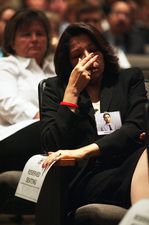 In February, I wrote about the similarities between the Colgan Air (flying as Continental Express) crash near Buffalo and an Express II (flying as Northwest Airlink) crash in Hibbing in the ’90s, noting that the big airlines — in the name of “branding” — don’t exactly go out of their way to make it clear to paying passengers that when they leave a big airliner and get on a smaller plane, they’re changing airlines and entering a different world.
In February, I wrote about the similarities between the Colgan Air (flying as Continental Express) crash near Buffalo and an Express II (flying as Northwest Airlink) crash in Hibbing in the ’90s, noting that the big airlines — in the name of “branding” — don’t exactly go out of their way to make it clear to paying passengers that when they leave a big airliner and get on a smaller plane, they’re changing airlines and entering a different world.
Why that fact matters is tragically apparent today as the National Transportation Safety Board holds a hearing into the crash and releases cockpit transcripts. Fact: Sometimes the pilots aren’t very qualified to transport you safely from one place to another.
The Washington Post reports:
First Officer Rebecca Shaw, in conversation with Captain Marvin Renslow, expressed wariness about the possibility of being promoted to captain without proper training.
“I’ve never seen icing conditions,” Shaw tells Renslow. “I’ve never de-iced. I’ve never seen any– I’ve never experienced any of that. I don’t want to have to experience that and make those kinds of call[s.] You know I’d have freaked out. I’d have, like, seen this much ice and thought, ‘Oh, my gosh, we’re going to crash.”
It gets worse. The captain in the crash had never received any training in the “stick shaker,” the device that warns pilots when the plane is dangerously slow and near “stalling” — falling out of the sky.
As I reported in February, the captain had over 3,000 of flight time. But nobody ever got around to teaching him about a critical safety device?
Matthew Wald, writing over the weekend in the New York Times, described a “safety net” that gets tighter with every crash. The problem is: It doesn’t. The way pilot Marvin Renslow slipped through the cracks — poorly trained and flunking flight tests — reads almost the same as the way Marvin Falitz, the pilot of the ill-fated Northwest Airlink flight in Hibbing, slipped through. The only difference seems to be the passage of 16 years.
It would be unfair, of course, to say that regional airlines as a rule are unsafe. But there are troubling — more than troubling — signs that systemically, they’ve got a problem.
Local regional pilot “Sam,” who writes the excellent Blogging at FL250, pointed to the crash of a regional jet on its way to Minneapolis (without passengers but with joyriding pilots) in 2004 as the “canary in a coal mine.”
When I wrote that post about regional airline safety, I regarded Pinnacle 3701 as a “Canary in the Coal Mine.” That accident was a quintessential regional airline accident. I don’t think it could have happened at the today’s major airlines. Once upon a time the majors suffered a string of similarly senseless accidents, but they ended up taking the lessons to heart, changed the way they did a lot of things, and ended up with a safety culture where reckless and careless behavior simply isn’t tolerated. There were a lot of lessons the regional airlines could’ve taken from Pinnacle 3701. Nobody really changed anything of importance, though. Maybe two lives and a destroyed airplane and house weren’t enough to grab their attention. Maybe it was too easy to write the pilots off as two loose cannons and miss the broader implications of their behavior.
Then there’s the 2003 Air Midwest accident that crashed in Charlotte, apparently because a mechanic had never worked on that kind of plane before. The NTSB said the FAA was aware of the training deficiencies, but had not addressed them.
A long-standing problem in airline safety in the United States is the NTSB doesn’t have the authority to force the FAA to do anything.
In the meantime, there are more efforts to help you find out that chocolate mulch can kill your dog, than to require airlines to tell you you’ve stepped onto an airline with questionable safety.
(Note: The NTSB Web site is down, but when it returns, you can find the Colgan Air documents here.)
